can anybody explain briefly how exactly these specifiers are working..i searched a lot about them but still confused about them.(i have a 32 bit pc).
#include<stdio.h>
int main()
{
int v,*p;
v=3;
*p=v;
printf("the value of v = %d \n",v);
printf("the address of v = %d \n\n",&v);
printf("the value of v = %p \n",v);
printf("the address of v = %p \n\n",&v);
printf("the value of v = %u \n",v);
printf("the address of v = %u \n\n",&v);
printf("the value of v = %x \n",v);
printf("the address of v = %x \n\n",&v);
printf("value stored through p = %d \n",*p);
printf("address of p = %d \n\n",p);
printf("value stored through p = %p \n",*p);
printf("address of p = %p \n\n",p);
printf("value stored through p = %u \n",*p);
printf("address of p = %u \n\n",p);
printf("value stored through p = %x \n",*p);
printf("address of p = %x \n\n",p);
return 0;
}
